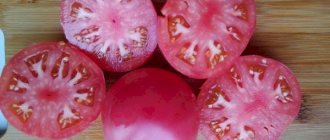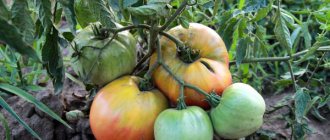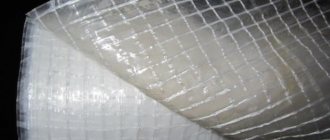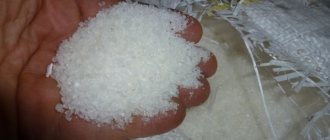Description of the Bear's Paw tomato
The variety was created by amateur breeders. The Bear's Paw tomato, the description of the variety, photos and reviews of which are listed below, was included in the State Register in 2005 as suitable for planting in open ground at dachas and small farms.
The plant is distinguished by a powerful bush. It can reach a height of 1.5 to 2 m. The leaves are dark green and have a classic tomato shape; they are larger and the green mass grows abundantly. Grow the Bear's Paw tomato variety as described with 1 or 2 stems. For the second type, the first stepson under the flowering branch is preserved. The remaining shoots are removed or pinched.
Indeterminate type variety. More suitable for warm climates. Feels good both in open ground and in greenhouses. Requires mandatory pinching.
Inflorescence of simple type. Starting from the 9th leaf, brushes grow at intervals of 1–2 leaves. The bush is capable of growing up to 30 brushes. Each bears 3-4 fruits. They ripen approximately on the 110th day from the moment of germination and further until the end of the season. This tomato is considered medium late.
Description of fruits
Tomatoes grow large and round in shape. They are slightly flattened and the ribbing characteristic of the variety is noticeable at the stalk. On average, a tomato weighs about 400 g, the largest ones can weigh up to 800 g. As they ripen, the color changes from green to dark red. The skin is glossy and soft. Inside, the tomato is fleshy with a significant volume of seed chambers. It is juicy, sweet with pronounced sourness. The Bear's Paw tomatoes in the photo are reminiscent of the name due to their size and shape.
Video
The following video shows how to properly form a Bear Paw tomato:
In the table below you will find links to other varieties of tomatoes presented on our website and having different ripening periods:
| Early ripening | Mid-late | Mid-early |
| Raspberry Viscount | Yellow banana | Pink Bush F1 |
| The Tsar Bell | Titanium | Flamingo |
| Kate | Slot F1 | Openwork |
| Valentina | Honey fireworks | Cio Cio San |
| Cranberries in sugar | Miracle of the market | Supermodel |
| Fatima | gold fish | Budenovka |
| Verlioka | De Barao black | Major F1 |
Characteristics of the Bear's Paw tomato
Large tomatoes become the pride of any gardener. With proper care, this variety can produce a rich harvest without much effort. The large, aromatic and juicy tomato does especially well in temperate and warm climates and is excellent for greenhouse cultivation.
Attention! With average care, the Bear's Paw variety produces about 5 clusters and ripens 7–12 kg of vegetables.
Productivity and fruiting
Ripening lasts throughout the season. The first tomatoes turn red 110–115 days after planting. Maturation occurs gradually from the lower to the upper hands. If you pick green tomatoes, they ripen well at home. And in a greenhouse, the last bunches can be harvested in September.
One Bear's Paw tomato bush, according to reviews and photos, produces up to 30 kg of tomatoes. The average yield is about 12 kg. It depends on care. It is important to correctly form the bush as it grows and remove excess leaves and prevent the formation of many trunks.
Area of application of fruits
The pleasant taste of tomato makes it indispensable in cooking. It is eaten fresh. Cut into salads, used as a base for sauces, and added to first and second courses. A ripe tomato produces delicious tomato juice. The variety is used for preparations for the winter. Bear's paw is well suited for transportation, retains its presentation for a long time and ripens quickly in room conditions.
Resistance to diseases and pests
Tomatoes of the Bear's Paw variety are resistant to the main diseases of this vegetable. By preventing verticillium, late blight, tobacco mosaic and fusarium wilt, the plant is protected from disease. Among the pests, the crop is afraid of aphids, slugs, Colorado potato beetles, mole crickets, whiteflies and spider mites.
Advantages and disadvantages of the variety
The benefits of the Bear's Paw tomato include:
- large tomato size, high commercial quality;
- good immunity to major diseases;
- drought resistance, does not require frequent watering;
- climatic adaptability: tolerates both hot summers and colder Siberian summers;
- productivity;
- ease of care;
- duration of crop storage.
According to reviews, the Bear Paw tomato variety has the following disadvantages:
- a tall bush with an abundance of greenery requires obligatory support;
- the need to form a bush as it grows;
- the fruits always have a slight sourness;
- if there is too much water, tomatoes crack;
- constant growth of green mass, requiring the removal of excess leaves and shoots.
Analogs
If we compare the mass of fruits of the Bear Paw variety with analogues, it is worth noting the following types of tomatoes:
| Name | Productivity per bush (kg) |
| Bear Paw | 25 |
| Apples in the snow | 3 |
| Visibly-invisibly | 13-16 |
| Early love | 2,5 |
| Samara | 6 |
| Baron | 7-9 |
| Podsinsky miracle | 12-14 |
| Cranberries in sugar | 3-4 |
| Yablonka Russia | 4-6 |
| Valentina | 11-13 |
Growing rules
The bear's paw tomato harvest, according to reviews and photos of those who planted it, completely depends on care. In warm regions it is better to plant it in open ground, while in colder climates greenhouses are preferable.
Planting seedlings
Planting begins approximately 60 days before the likely date of transplantation into the ground. The Bear's Paw tomato variety prefers a nutritious mixture of garden or turf soil with the addition of humus. You can add a little river sand. Seeds are sown in large containers and left under a film until germination.
Attention! Soaking tomato seeds for 10–12 hours in a stimulant and washing them with a manganese solution will improve germination and prevent the development of diseases.
After germination, the containers are placed near southern windows and illuminated in the absence of sun. The variety prefers moderate watering with warm, settled water. Loosen the soil about once a week. Plant in separate pots after 2 leaves have germinated. Make the first fertilizing with nitrogen fertilizers.
Tomato transplant
The greatest harvest can be obtained when planted in a greenhouse. The best time is the end of May, when the earth has warmed up well and the bush has 5-6 well-developed leaves. To plant in open ground, the ground and air must also warm up. The soil for tomatoes is prepared in the fall; they try not to plant them in the same place for 2 years in a row. The optimal planting scheme is 3 bushes per 1 square. m. The distance between the holes is 60 cm, the rows are arranged in a checkerboard pattern.
Subsequent care for tomatoes
This variety of tomato does not like excessive watering; it leads to fungal diseases. Depending on the weather, the bushes are watered into the hole with warm water a couple of times a week, 3–5 liters in the morning. Tends to drop the ovary when watered with cold water. After watering, the hole is mulched with pine needles, dry nettles or compost, otherwise the soil must be constantly loosened to break up the hard crust.
Feeding the Bear's Paw tomato, according to reviews, is done a week after planting in the ground with mineral fertilizers (30 g of superphosphate or potassium sulfate per 10 liters of water). During flowering, you can spray with boric acid. From traditional fertilizers, ash is added to the soil with watering.
As the trunk grows, it is tied up, and individual brushes also need support so that they do not break off. The stakes are installed in the holes of the tomato. An alternative to them is the grid. We weed the beds when the weeds grow to 10–15 cm.
Pruning is carried out regularly; the variety is prone to overgrowing and thickening of the crown. They are removed by hand or with scissors treated with potassium permanganate in the morning.
Disembarkation methods
This variety is more efficiently grown through seedlings. In this case, the tomato harvest is obtained much earlier. To increase the germination of your own or purchased seeds, they are soaked in Epin’s solution before planting; some gardeners soak planting material in aloe juice or hydrogen peroxide.
As soon as the first shoots begin to appear, after about 6-8 days, the box with the seedlings is placed in a well-lit place. The seedlings will be ready in 2 months for planting in open ground (in warm regions) or in greenhouses (in colder climates).
Pest and disease control
Disease prevention is carried out by treating the soil with a hot solution of potassium permanganate before planting Bear's Paw seedlings. To prevent root rot and other types of rot, after watering in greenhouses, open the windows, and mulch the plant holes in the soil with peat or straw.
An aqueous solution of ammonia saves the tomato variety from the Colorado potato beetle and slugs. Aphids are expelled by spraying with soapy water. Insecticide sprays protect tomatoes from flying insects.
Attention! After the formation of the ovary, spraying is carried out only with decoctions of chamomile, celandine, and onion peels. When one bush is infected, the entire plot is treated.
Reviews about the variety
Gardeners have different opinions; some like the variety, others don’t. Here are some opinions:
Tomat-pomidor forum
Forum forumhouse.ru
We are interested in your opinion about this variety, share your impressions in the comments!
Landing algorithm
You can start planting seedlings from the beginning - mid-May, when the soil warms up enough.
The procedure consists of the following steps:
- Dig holes with dimensions of 25*30 cm, and a step between them of 60 cm. The row spacing should reach 60-65 cm.
- Pour 2-3 liters of warm water into the holes.
- Remove the seedlings from the containers, being careful not to destroy the earthen ball. Plants planted in peat pots along with them.
- When the moisture is absorbed, plant the tomatoes in the holes one at a time. It is important to deepen them to the cotyledon leaves. Very elongated seedlings should be buried down to the true leaves, placing the seedlings on a slope.
- Lightly compact the soil under the bushes and water generously.
It is better to immediately mulch the surface of the bed with peat, straw or sawdust, in a layer of 5-10 cm.











